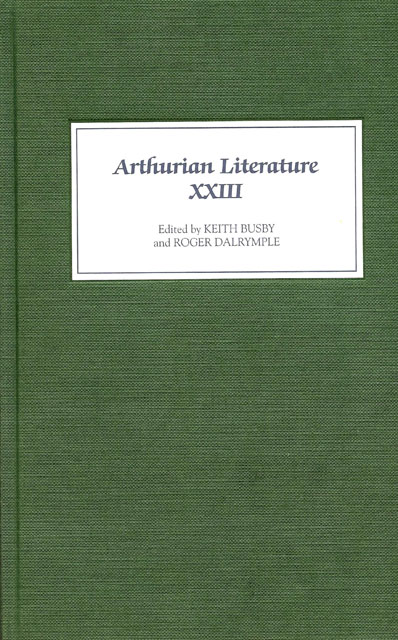Book contents
- Frontmatter
- Contents
- General Editor’s Foreword
- I Beyond Shame: Chivalric Cowardice and Arthurian Narrative
- II Malory’s Forty Knights
- III Fooling with Language: Sir Dinadan in Malory’s Morte Darthur
- IV William Caxton, Wynkyn de Worde and the Editing of Malory’s Morte Darthur
- V Ballad and Popular Romance in the Percy Folio
- VI Local Hero: Gawain and the Politics of Arthurianism
- VII Promise-postponement Device in The Awntyrs Off Arthure: a Possible Narrative Model
- VIII L’Atre perilleux and the Erasure of Identity
- IX The Theme of the Handsome Coward in the Post-Vulgate Queste del Saint Graal
- X A Time of Gifts? Jean de Nesle, William A. Nitze and The Perlesvaus
- XI Thomas Love Peacock’s The Misfortunes of Elphin and the Romantic Arthur
- Contents of Previous Volumes
VII - Promise-postponement Device in The Awntyrs Off Arthure: a Possible Narrative Model
Published online by Cambridge University Press: 23 March 2023
- Frontmatter
- Contents
- General Editor’s Foreword
- I Beyond Shame: Chivalric Cowardice and Arthurian Narrative
- II Malory’s Forty Knights
- III Fooling with Language: Sir Dinadan in Malory’s Morte Darthur
- IV William Caxton, Wynkyn de Worde and the Editing of Malory’s Morte Darthur
- V Ballad and Popular Romance in the Percy Folio
- VI Local Hero: Gawain and the Politics of Arthurianism
- VII Promise-postponement Device in The Awntyrs Off Arthure: a Possible Narrative Model
- VIII L’Atre perilleux and the Erasure of Identity
- IX The Theme of the Handsome Coward in the Post-Vulgate Queste del Saint Graal
- X A Time of Gifts? Jean de Nesle, William A. Nitze and The Perlesvaus
- XI Thomas Love Peacock’s The Misfortunes of Elphin and the Romantic Arthur
- Contents of Previous Volumes
Summary
Introduction
Readers and critics of the late medieval Arthurian poem The Awntyrs Off Arthure will inevitably find themselves taking sides in the debate over the success or failure of the poem's narrative structure. For most of the twentieth century, the poem was widely perceived as something of a failed literary experiment, its moral and secular episodes seen as artlessly juxtaposed rather than linked in any meaningful way. A vigorous debate, beginning properly in the 1970s, has since turned perceptions around, making the present climate much more accepting of the poem's design. Curiously, though, while much has been written on the poem as a finished literary entity, and much on the source of elements or sections of the poem, no one has extensively investigated possible structural analogues for the poem as a whole. This has tended to make the task of understanding the poet's design, or gauging the relative success or failure of the poem, all the more challenging.
Thankfully, however, we do not have to look very far for indications of a pre-existing narrative model that may have influenced the Awntyrs poet. The Trentals of St Gregory is a work consistently cited as a likely source of the Awntyrs’ first episode, the ghostly encounter in the Forest of Inglewood. The Trentals story pre-dates the Awntyrs and possesses many of the most important elements of that first episode: the appearance of the spirit of a deceased mother in a state of terrible decay owing to undisclosed sinfulness, and the extraction of a promise from the offspring to have Trental masses said as a means to cleanse and atone. This, however, is really only half the story, as The Trentals of St Gregory is properly represented by two distinct versions. While the ‘A’ version is the one cited exclusively by Awntyrs criticism to date, I will demonstrate that its lesser-known ‘B’ version also deserves to be taken into account in any consideration of the Awntyrs’ possible source debt. The main distinguishing element between the Trentals A and B is the latter's inclusion of a passage between the decision by the pope to carry out the promise to his mother's spirit and the actual completion or fulfilment of that promise. The passage recounts the actions of a series of devils who repeatedly attempt to thwart the pope from completing his mission to say the thirty trental masses in aid of his mother's spirit. This passage, I will argue, can be seen as a literary device playing a somewhat similar role to that which the Sir Galeron episode plays in the Awntyrs: in both works, the fulfilment of a promise is postponed by an interrupting action. This interrupting action is necessarily and purposefully different, in terms of tone and style, from the foregoing narrative and helps to explain the perceived clash of narratives within the one poem. I will further trace this ‘promise-postponement’ narrative device back to its apparent literary origins, proposing that enough of a convention existed for us to be able to say that the poet of The Awntyrs Off Arthure may at least have been aware of it, and possibly had it in mind in the construction of his poem.
- Type
- Chapter
- Information
- Arthurian Literature XXIII , pp. 95 - 108Publisher: Boydell & BrewerPrint publication year: 2006



